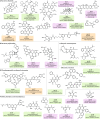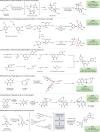Demystifying racemic natural products in the homochiral world
- PMID: 36259059
- PMCID: PMC9562063
- DOI: 10.1038/s41570-022-00431-4
Demystifying racemic natural products in the homochiral world
Abstract
Natural products possess structural complexity, diversity and chirality with attractive functions and biological activities that have significantly impacted drug discovery initiatives. Chiral natural products are abundant in nature but rarely occur as racemates. The occurrence of natural products as racemates is very intriguing from a biosynthetic point of view; as enzymes are chiral molecules, enzymatic reactions generating natural products should be stereospecific and lead to single-enantiomer products. Despite several reports in the literature describing racemic mixtures of stereoisomers isolated from natural sources, there has not been a comprehensive review of these intriguing racemic natural products. The discovery of many more natural racemates and their potential enzymatic sources in recent years allows us to describe the distribution and chemical diversity of this 'class of natural products' to enrich discussions on biosynthesis. In this Review, we describe the chemical classes, occurrence and distribution of pairs of enantiomers in nature and provide insights about recent advances in analytical methods used for their characterization. Special emphasis is on the biosynthesis, including plausible enzymatic and non-enzymatic formation of natural racemates, and their pharmacological significance.
Keywords: Biosynthesis; Natural products; Pharmacology; Structure elucidation.
© Springer Nature Limited 2022, Springer Nature or its licensor holds exclusive rights to this article under a publishing agreement with the author(s) or other rightsholder(s); author self-archiving of the accepted manuscript version of this article is solely governed by the terms of such publishing agreement and applicable law.
Conflict of interest statement
Competing interestsThe authors declare no competing interests.
Figures





Similar articles
-
Demystifying racemic natural products in the homochiral world.Nat Rev Chem. 2022 Nov;6(11):806-822. doi: 10.1038/s41570-022-00431-4. Epub 2022 Oct 14. Nat Rev Chem. 2022. PMID: 37118098 Review.
-
Structures formed by the chiral assembly of racemic mixtures of enantiomers: iodination products of elaidic and oleic acids.J Phys Chem B. 2005 Mar 17;109(10):4514-9. doi: 10.1021/jp0466587. J Phys Chem B. 2005. PMID: 16851527
-
Analogues of Anticancer Natural Products: Chiral Aspects.Int J Mol Sci. 2023 Mar 16;24(6):5679. doi: 10.3390/ijms24065679. Int J Mol Sci. 2023. PMID: 36982753 Free PMC article. Review.
-
[Chiral switch: pure enantiomers of drugs instead of racemic mixtures].Ceska Slov Farm. 2004 Nov;53(6):285-93. Ceska Slov Farm. 2004. PMID: 15630994 Czech.
-
The real gordian knot: racemic mixtures versus pure enantiomers.Drug News Perspect. 1998 Apr;11(3):139-60. doi: 10.1358/dnp.1998.11.3.863651. Drug News Perspect. 1998. PMID: 15616615
Cited by
-
Perspectives on Computational Enzyme Modeling: From Mechanisms to Design and Drug Development.ACS Omega. 2024 Feb 8;9(7):7393-7412. doi: 10.1021/acsomega.3c09084. eCollection 2024 Feb 20. ACS Omega. 2024. PMID: 38405524 Free PMC article. Review.
-
Identification and Detection of a Peptide Biomarker and Its Enantiomer by Nanopore.ACS Cent Sci. 2024 May 3;10(6):1167-1178. doi: 10.1021/acscentsci.4c00020. eCollection 2024 Jun 26. ACS Cent Sci. 2024. PMID: 38947203 Free PMC article.
-
Determination of the Absolute Configuration of Secondary Alcohols in a Compound Mixture via the Application of Competing Enantioselective Acylation Coupled with LC/MS Analysis.Pharmaceutics. 2024 Mar 5;16(3):364. doi: 10.3390/pharmaceutics16030364. Pharmaceutics. 2024. PMID: 38543258 Free PMC article.
-
Discovery, Herbicidal Activity and Biosynthesis of a Novel Natural Tetramic Acid from Alternaria Species.Adv Sci (Weinh). 2025 Jun;12(21):e2416188. doi: 10.1002/advs.202416188. Epub 2025 Apr 25. Adv Sci (Weinh). 2025. PMID: 40278415 Free PMC article.
-
Cytotoxic, Antibacterial, and Antioxidant Activities of the Leaf Extract of Sinningia bullata.Plants (Basel). 2023 Feb 14;12(4):859. doi: 10.3390/plants12040859. Plants (Basel). 2023. PMID: 36840206 Free PMC article.
References
-
- Sharma B. Nature of chiral drugs and their occurrence in environment. J. Xenobiotics. 2014;4:14–19. doi: 10.4081/xeno.2014.2272. - DOI
-
- Devínsky F. Chirality and the origin of life. Symmetry. 2021;13:2277. doi: 10.3390/sym13122277. - DOI
-
- Kittakoop P. Part 2: occurrence of racemic natural products and their biological activities. J. Chulabhorn R. Acad. 2020;2:27–43.
Publication types
LinkOut - more resources
Full Text Sources

